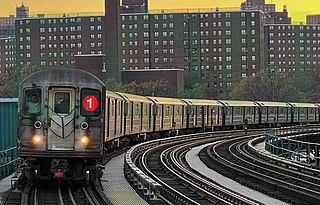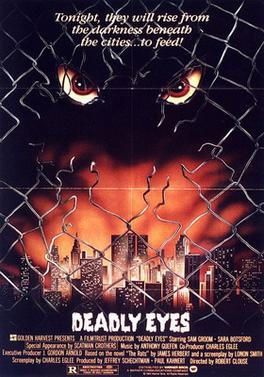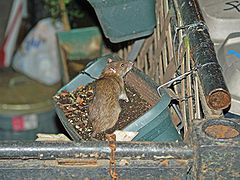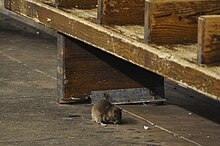
Rats are various medium-sized, long-tailed rodents. Species of rats are found throughout the order Rodentia, but stereotypical rats are found in the genus Rattus. Other rat genera include Neotoma, Bandicota and Dipodomys.

Harlem is a neighborhood in Upper Manhattan, New York City. It is bounded roughly by the Hudson River on the west; the Harlem River and 155th Street on the north; Fifth Avenue on the east; and Central Park North on the south. The greater Harlem area encompasses several other neighborhoods and extends west and north to 155th Street, east to the East River, and south to Martin Luther King Jr. Boulevard, Central Park, and East 96th Street.

The brown rat, also known as the common rat, street rat, sewer rat, wharf rat, Hanover rat, Norway rat and Norwegian rat, is a widespread species of common rat. One of the largest muroids, it is a brown or grey rodent with a body length of up to 28 cm (11 in) long, and a tail slightly shorter than that. It weighs between 140 and 500 g. Thought to have originated in northern China and neighbouring areas, this rodent has now spread to all continents except Antarctica, and is the dominant rat in Europe and much of North America. With rare exceptions, the brown rat lives wherever humans live, particularly in urban areas.

Flushing Meadows–Corona Park, often referred to as Flushing Meadows Park, or simply Flushing Meadows, is a public park in the northern part of Queens in New York City, New York, U.S. It is bounded by I-678 on the east, Grand Central Parkway on the west, Flushing Bay on the north, and Union Turnpike on the south. Flushing Meadows–Corona Park is the fourth-largest public park in New York City, with a total area of 897 acres (363 ha).

The New York City Subway is a rapid transit system in the New York City boroughs of Manhattan, Brooklyn, Queens, and the Bronx. It is owned by the government of New York City and leased to the New York City Transit Authority, an affiliate agency of the state-run Metropolitan Transportation Authority (MTA). Opened on October 27, 1904, the New York City Subway is one of the world's oldest public transit systems, one of the most-used, and the one with the most stations, with 472 stations in operation.

Harlem–125th Street station is a commuter rail stop serving the Metro-North Railroad's Hudson, Harlem, and New Haven Lines. It is located at East 125th Street and Park Avenue in East Harlem, Manhattan, New York City. The station also serves as an important transfer point between the Metro-North trains and the New York City Subway's IRT Lexington Avenue Line for access to the Upper East Side of Manhattan. It is the only station besides Grand Central Terminal that serves all three lines east of the Hudson River. Trains leave for Grand Central Terminal, as well as to the Bronx and the northern suburbs, regularly.

Pest control is the regulation or management of a species defined as a pest; such as any animal, plant or fungus that impacts adversely on human activities or environment. The human response depends on the importance of the damage done and will range from tolerance, through deterrence and management, to attempts to completely eradicate the pest. Pest control measures may be performed as part of an integrated pest management strategy.

Rodenticides are chemicals made and sold for the purpose of killing rodents. While commonly referred to as "rat poison", rodenticides are also used to kill mice, woodchucks, chipmunks, porcupines, nutria, beavers, and voles. Despite the crucial roles that rodents play in nature, there are times when they need to be controlled.

The farm cat, also known as a barn cat, is a domestic cat, usually of mixed breed, that lives primarily outdoors, in a feral or semi-feral condition on agricultural properties, usually sheltering in outbuildings. They eat assorted vermin such as rodents and other small animals that live in or around outbuildings and farm fields. The need for the farm cat may have been the original reason cats were domesticated, to keep rodents from consuming or contaminating grain crops stored for later human consumption. They are still commonly kept for their effectiveness at controlling undesired vermin found on farms, ranches, greenhouses, and even drug farms, which would otherwise eat or contaminate crops, especially grain or feed stocks. Farm cats hunt the rodent population, and their pheromones keep further rodents from filling the void.

Environmental issues in New York City are affected by the city's size, density, abundant public transportation infrastructure, and location at the mouth of the Hudson River.

Deadly Eyes is a 1982 Canadian horror film directed by Robert Clouse, very loosely based on the 1974 horror novel The Rats by James Herbert. The story revolves around giant black rats who begin eating the residents of Toronto after ingesting contaminated grain.

Verdi Square is a 0.1-acre (400 m2) park on a trapezoidal traffic island on the Upper West Side of Manhattan in New York City. Named for Italian opera composer Giuseppe Verdi, the park is bounded by 72nd Street on the south, 73rd Street on the north, Broadway on the west, and Amsterdam Avenue on the east. Verdi Square's irregular shape arises from Broadway's diagonal path relative to the Manhattan street grid. The western half of the park is built on the former northbound lanes of Broadway, which were closed permanently in 2003 during a renovation of the New York City Subway's adjacent 72nd Street station. Verdi Square is designated as a New York City scenic landmark and is maintained by the New York City Department of Parks and Recreation.

Eric Leroy Adams is an American politician and former police officer, currently serving as the 110th mayor of New York City since 2022. An ideologically moderate member of the Democratic Party, Adams was an officer in the New York City Transit Police and then the New York City Police Department (NYPD) for more than 20 years, retiring at the rank of captain. He served in the New York State Senate from 2006 to 2013, representing the 20th Senate district in Brooklyn. In November 2013, Adams was elected Brooklyn Borough President, the first African-American to hold the position, and reelected in November 2017.

Bubonic plague is one of three types of plague caused by the bacterium Yersinia pestis. One to seven days after exposure to the bacteria, flu-like symptoms develop. These symptoms include fever, headaches, and vomiting, as well as swollen and painful lymph nodes occurring in the area closest to where the bacteria entered the skin. Acral necrosis, the dark discoloration of skin, is another symptom. Occasionally, swollen lymph nodes, known as "buboes", may break open.

Rodents are mammals of the order Rodentia, which are characterized by a single pair of continuously growing incisors in each of the upper and lower jaws. About 40% of all mammal species are rodents. They are native to all major land masses except for New Zealand, Antarctica, and several oceanic islands, though they have subsequently been introduced to most of these land masses by human activity.

α-Naphthylthiourea (ANTU) is an organosulfur compound with the formula C10H7NHC(S)NH2. This a white, crystalline powder although commercial samples may be off-white. It is used as a rodenticide and as such is fairly toxic. Naphthylthiourea is available as 10% active baits in suitable protein- or carbohydrate-rich materials and as a 20% tracking powder.
A ratter is any dog used for catching and killing rats and similar vermin. Specialized rat-catching breeds are found in many countries. A typical ratter is small to medium-sized and has a short and smooth coat, however a wide range of dog breeds and landraces may be used. The use of ratting dogs is widely considered to be the most environmentally friendly, humane and efficient methods of exterminating rodents. Ratting dogs are considered more efficient than domestic cats.
Pizza Rat is an internet meme based around a viral video of a brown rat carrying a slice of pizza down the steps of a New York City Subway station in Manhattan. The video was first uploaded to Instagram on September 21, 2015, and a copy was uploaded to YouTube later. As of September 2023, the YouTube video has more than 12.35 million views.

The Farragut Houses is a public housing project located in the downtown neighborhood of northwestern Brooklyn, New York City, bordering the Brooklyn Navy Yard. Farragut Houses is a property of New York City Housing Authority (NYCHA). The houses contain 3,272 residents who reside in ten buildings that are each 13 to 14 stories high.
Ryders Alley Trencher-fed Society (R.A.T.S.) is a New York City group founded in the 1990s that conducts organized rat catching with ratting dogs. The group was named by founding member Richard Reynolds after Ryders Alley in Manhattan, which was once rat infested, and the trencher-fed pack assembled to hunt. The group often hunts in Lower Manhattan locations like Theatre Alley where garbage is accessible to vermin.




















